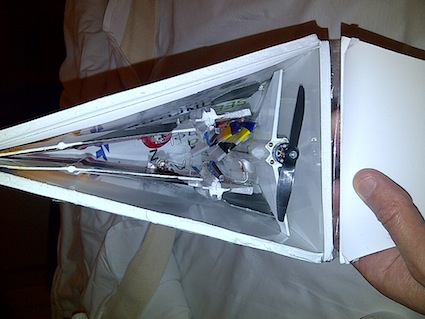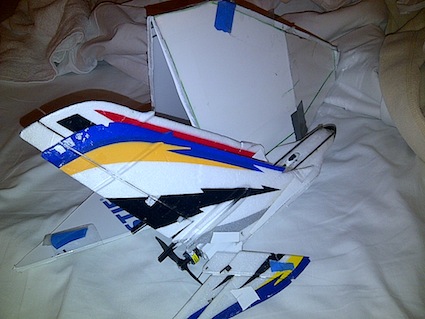 |
Flying High With Electric Power!
The Ampeer ON-LINE!
Fly the Future - Fly Electric! |
Site Table of Contents
| President: | Vice-President: | Secretary/Treasurer: |
| Ken Myers | Richard Utkan | Rick Sawicki |
| 1911 Bradshaw Ct. | 240 Cabinet | 5089 Ledgewood Ct. W. |
| Commerce Twp., MI 48390 | Milford, MI 48381 | Commerce Twp., MI 48382 |
| (248) 669-8124 | (248) 685-1705 | 248.685.7056 |
 | ||
| Board of Directors: | Board of Directors: | Ampeer Editor |
| David Stacer | Arthur Deane | Ken Myers |
| 16575 Brookland Blvd. | 21690 Bedford Dr. | 1911 Bradshaw Ct. |
| Northville, MI 48167 | Northville, MI 48167 | Commerce Twp., MI 48390 |
| 248.924.2324 | 248.348.2058 | 248.669.8124 |
| Mailed Ampeer printed subscriptions are no longer available.
The Ampeer is FREE on-line in Acrobat .pdf format and HTML with active links! | ||
| The Next Meeting:
Date: Wednesday, April 8 Time: 7:30 p.m. Place: Ken Myers' house, Commerce Twp., MI 48390 | ||
| What's In This Issue? | ||||
| Flyzone Tiger Moth & Tactic TTX850 Update Ken Myers describes how he found the wing cube loading of the Flyzone Tiger Moth and updates the performance of the Tactic TTX850 in the all metal Ultimate Soccer Arenas. | Upcoming Keith Shaw Birthday Party Electric Fly-in 2015 - Info and map for this upcoming event. | |||
| Flyzone Sensei RTF (Ready To Fly) Review - Ken reviews this excellent trainer. | Hobbico to Visit Our Area for Two Days in April! Joe Hass presents info on this two day event.. | |||
| Team USA F3P Pilot Ryan Clark Visits Ultimate Soccer, February 10, 2015, Joe Hass reports on this event. | An A123 Distributor Closing, Erik Vandermey, buyA123.com will no longer be selling A123 cells. | |||
| A Take Along Folding Plane, Mark Couling describes how he folds up a mini-Stryker to take it along on business trips. | 31st Annual Mid-America Electric Flies 2015, info and links to the flyer and hotels and field map. | |||
|
By Ken Myers On Monday, January 19, I flew the Tactic TTX850 mated to the Flyzone Tiger Moth for three flights at the Ultimate Soccer Arenas in Pontiac, MI. The combination performed flawlessly in this indoor venue with a lot more metal than the flights taken at the Legacy Center in Brighton, MI. I recommend the Tactic TTX850 for those looking for more channels and more model memory than the Tactic TTX650. While I was at the venue, I mentioned, to Pete Foss, that the Tiger Moth is a very easy to fly 3-channel plane. I also mentioned that I was surprised that the glide was so very short. Pete suggested that the short glide is probably due to the low mass of the model. He also said, "I wonder what the wing cube loading factor is for that plane." I decided to use the lost area method to calculate the wing area of this small model. First I measured a sheet of printer paper in millimeters (mm). I used mm because it is more accurate than inches. It measured 216.5mm wide and 279mm long. Next I converted the metric measurements to inches so that the sheet's area in square inches (sq.in.) could be calculated.
10 sheets were weighed from the same source of paper. They weighed 45.1g or 1.5909 ounces (oz.). The top and bottom wing panels were traced onto one sheet of paper. The four wing panels were cut from the sheet of paper. The 9 sheets of paper and the sheet with the wing panels removed were weighed. The weight of the paper was 42.2g or 1.4886 oz.
The center sections were measured:
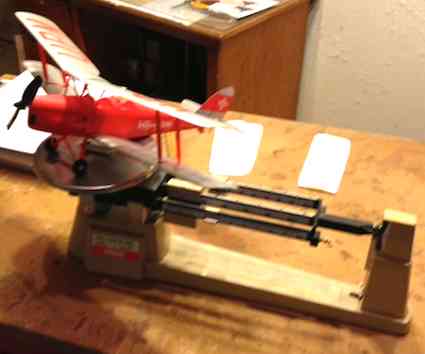 The Ready To Fly (RTF) Weight, measured on a triple beam balance scientific scale, including the Flyzone 140mAh 20C single cell, was 30.35g or 1.0706 oz. Wing area loading:
Wing Cube Loading Factor:
Upcoming Keith Shaw Birthday Party Electric Fly-in 2015 The Balsa Butchers will once again be hosting the "Keith Shaw Birthday Party Electric Fly-In" at their field near Coldwater, MI. The event will take place on June 6 and June 7, 2015. Contest Director: Dave Grife - E-mail: grifesd@yahoo.com or Phone: 517.279.8445
The Flying Field will be open Friday, June 5 for early arrivals. Saturday, June 6, hours are from 9 a.m. 'til 4 p.m.
Landing Fee is $15 for the weekend. Directions: Quincy is approximately 4.5 miles east of I-69. Clizbe Road is approximately 1.6 miles east of Quincy. The Flying site is approximately 1.5 miles south of US-12 on the west side of Clizbe Road. |
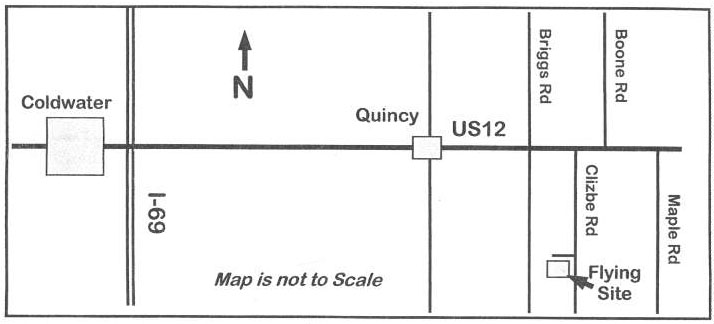
|
By Ken Myers In June of 2014, one of my student pilots in training wanted to purchase a 'trainer' plane. I recommended the E-flite Apprentice S 15e RTF with SAFETM Technology or the Flyzone Sensei RTF. I have flown both planes, and both work well as trainers. I gave him the information on both planes and he decided to go with the Sensei. The Sensei is produced for Hobbico's Flyzone brand by Sheng Teng Electric R/C Model Plane Co., LTD, which is also known as ST Model. ST Model also produces the same airframe for Ripmax in the UK, where is known as the ST Model Discovery, and the Kyosho Hype series with the name U CAN FLY. The RTF versions use distributor specific radio brands. While waiting for the plane to arrive, the Flyzone Sensei manual, and two updates/technical bulletins were downloaded from the Tower Hobbies' Sensei RTF page. One of the updates was a 'how to' on removing the glued on cowl and the other one was a tip to help with inserting the plastic wing joiner. It is EXTREMELY IMPORTANT to read, understand and follow the directions in the AMA "EMERGENCY LIPO BATTERY SAFETY ALERT". It is available as a .pdf document and linked from the Sensei RTF page. On page 2 of the Sensei manual it notes, "For the latest technical updates or manual corrections to the Sensei visit the Hobbico web site at www.hobbico.com. Open the "Airplanes" link, then select "Sensei"." This is incorrect. There is no "Airplanes" link on that page. You have to 'surf' around the site to finally get to the Sensei information. The direct link is here. In the menu selection for RTF Parts & Tech Info on the Sensei page, I found the previously downloaded wing joining and cowl tech notes. The Specifications: The Specifications are derived from the various supplier manuals and Web sites.Actual measurement data (Myers) was added after the plane arrived. |

|
The WCL Factor is typical for a park flyer, but it does not qualify as a park flyer under the AMA definition, as it exceeds 2 pounds. This plane is for use at a club flying field. To familiarize myself with the aircraft assembly and radio operation, I read through the manual. The supplied charger is a Great Planes 3S LiPo Smart Charger w/DC Car Adapter and AC/DC adapter. It is Stock# GPMM3319. To be as safe as possible, the #3319 charger charges ONLY 3S LiPo batteries between 1250mAh and 2100mAh, according to the information about the charger on the Tower Hobbies Web site. The charge current is NOT adjustable and set at 800mA or 0.8A. That is 0.38C for a 2100mAh LiPo battery. (You read that correctly.) That means that a completely depleted 2100mAh pack might take up to two and a half to three hours to charge. The manual notes, "The Smart Charger will take approximately 4-1/2 hours to fully charge the battery." The Sensei RTF manual also notes that the charger will automatically shut down after 2-hours and 40-minutes. The supplied radio system is a Tactic TTX600 transmitter and Tactic TR624 receiver. The servos, 30-amp ESC and brushless outrunner motor are preinstalled. The full manual for the Tactic TTX600 transmitter is located on the Hobbico Web site. After perusing the Sensei manual, I checked out the Airplane Reviews link on the Sensei RTF page on Tower Hobbies Web site and found three video reviews and a written review. Video and written review on Rx-R version by 2 Brothers Hobby Video review by Eric at AroundTuitRC of Rx-R version - he does have the main landing gear on backwards, he is shown flying it at a school, I DO NOT recommend EVER doing that with this size and weight plane! Video review by TheRcSaylors of Rx-R version, this is really more of a review of the Tactic TTX650 transmitter used with this plane for training Review by Geoff Barber on RCUniverse of Rx-R version
There is also a large Sensei thread on RC Groups. The Sensei arrived: The order for the Sensei RTF was placed at 5:45 a.m. on Monday, June 23 and arrived via UPS at 3:11 p.m. on Wednesday, June 25. There was absolutely no damage to the outside shipping box or the outside of the Sensei box. The kit was inspected to see if all of the parts were there and if there was any pre-shipping damage. 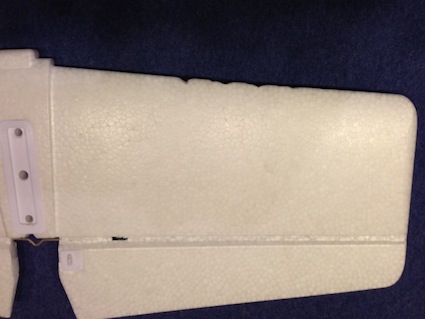 Unfortunately, the horizontal stabilizer/elevator assembly had a very noticeable blemish. It had four very noticeable gouges in the leading edge of the right panel. From the way the Sensei was packed, my guess is that the main landing gear 'banged' it during shipping. All of the required parts were present and accounted for, and there are not a lot of them. An email regarding the gouges was sent to Hobbico and a replacement sent out immediately. Instead of following the well illustrated instruction manual, since I was waiting on the replacement, I checked out the rest of the electronics. Voltages as shipped for the Flyzone 3S 2100mAh LiPo batteries:
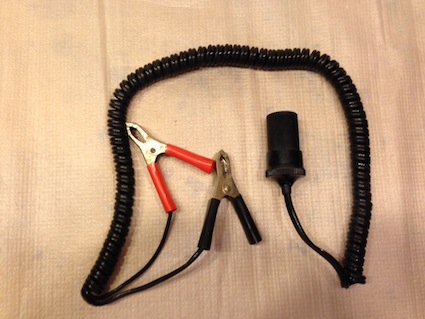 The charger was checked using both the AC adapter and 12V car adapter with a Radio Shack alligator clip: 12V lighter adapter. Radio Shack doesn't exist anymore, but I noticed that hobby shops should carry a similar car lighter adapter. Horizon Hobby brands their adapter under several different names. Under absolutely NO circumstances is a LiPo battery to be charged in a vehicle! The farther away from a vehicle the better. Actually, a vehicle 12V battery is not a good charging source. It is not designed for that purpose. A 12V Marine/RV battery is a much better choice. The supplied 4 AA batteries were installed in the Tactic TTX600 transmitter. The battery box design makes this more difficult than necessary as the cells want to pop out before the battery cover can be replaced. The connectors supplied on the battery and ESC are SuperTigre LiPo Battery & ESC Plug ST. They are extremely difficult to plug together and unplug. With the radio turned on, one of the LiPo batteries was plugged in. It was apparent that the Tactic TR624 receiver was factory bound or linked to the transmitter. When the battery was plugged in, there was servo buzzing. The battery was disconnected as quickly as possible and the transmitter turned off. The screws were loosened in the rudder and elevator pushrod screw lock connectors. The elevator and rudder pushrods were pushed back and forth to check their freedom of movement. The rudder pushrod seemed to be 'caught' but was freed by moving it back and forth and twisting it a few times. The transmitter was turned on and battery plugged in again. There was still servo buzzing. It was the drop hatch servo. The battery was unplugged and the transmitter turned off. The pushrod needed to be lengthened by squeezing on the V-bend in the all metal pushrod to extend its length slightly and stop binding the servo. The "Y" harness was plugged into Ch1 of the receiver and the aileron servos plugged in and checked. They were okay. Weights and Measures 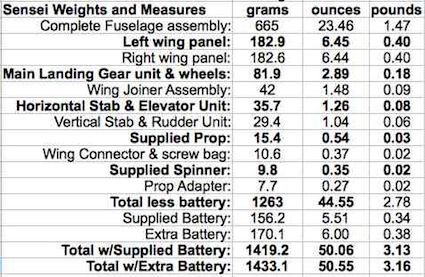 It appears that the given Ripmax and Hype weight of 1250g is for everything except the LiPo battery. There was a bit of surprise when weighing the supplied LiPo battery. When compared with the one purchased as an extra, it was much lighter. Both of the 3S 2100mAh LiPo batteries have identical labels and part numbers; FLZA6173. They are wrapped in the same shrink wrap with the same look. The reason the 'extra' battery weighs more is that it is a bit physically larger.  This is neither a good or bad thing, but just an observation. Wing Area: The right wing panel was used to measure the wing area. It was traced onto 6 sheets of printer paper and then the measurements for root chord, tip chord, span and sweep were taken. The leading edge sweep was needed to verify the CG later on. The measurements yield a wing area of 576 sq.in. The paper weighing method yield 571 sq.in. Both areas are right in the ballpark with the stated 566 sq.in. at about a 1.5% difference. Still, while waiting for the replacement, the Super Tigre connectors on the batteries and ESC were changed to Anderson Power Poles (APP). Assembly: The Sensei manual is much better, in many regards, when compared to the Hype or German version that Ripmax points to on their Web site. One of the last steps in assembly in the Sensei manual is affixing the propeller, while in the other two manuals it is one of the first. There is no reason to attach the propeller and spinner until the Center of Gravity (CG) is going to be checked. No glue is used in the assembly. The Sensei manual's clear photos of each step are easy to follow. The wing joiner holes needed to be cleaned up slightly for the wing joiner to fit correctly. I cleaned up the holes with a couple of turns of a non-step reamer. The Fastlinks attachment, for securing the rudder and elevator pushrods to their control horns, are a bit fiddly and require some patience. The Sensei is provided with two pieces of self-stick 'fuzzy' hook-and-loop fasteners. There is a 'nubby' side hook-and-loop fastener on the left side of the battery compartment. There are no photos of the battery installation and no notes about what to do with the hook-and-loop fastener. This could be a problem for someone who's never seen how batteries are commonly attached in a RC plane. "About 1/2 the of one length of the 'fuzzy' side fastener is attached to the side of the battery pack. The pack is positioned in the battery compartment and then lightly pressed against the preinstalled 'nubby' side fastener. Hint: An old plastic credit card-type card cut in half lengthwise makes and excellent tool for releasing hook and loop fasteners. Slide the 1/2-card between the fasteners and lift out the battery. No 'yanking' on the wires, etc. is necessary. 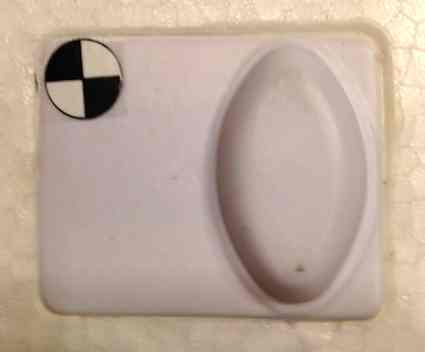 There are CG indicator graphics, a circle that is divided into quarters with opposing quarters filled with black, on the servo covers. Hobbico indicates a slightly different CG in the Sensei manual. I ran the calculations for an initial safe center of gravity and from the middle of the CG graphic to 1/4" in front of the servo cover should be just fine. The Power System Tower Hobbies notes that the motor is a brushless 30-22-1350kV. I did not do my 'normal' power system test, as the supplied 30-22-1350Kv motor is not accessible as the cowl is not easily removed. It is glued on. The electronic speed control (ESC) is said to be a 30A (amp) unit with BEC for 3S LiPo only. There are no instructions for the ESC, except how to set and unset the brake. There is an ESC manual available at the Hype site, but it too only provides brake setting information. The Hype ESC manual indicates that it is for 2S or 3S LiPo batteries. Using the supplied freshly charged LiPo battery and the supplied 10x5 prop, the Emeter II read 11.83V, 25.4 amps, and 301 watts in, RPM 10,020, pitch speed 47.4 mph. That is 96.3 watts in per pound of RTF weight. Flying There is not too much to say about flying the plane. It flies like a well designed trainer. When throttled back, it can float through the air. It has plenty of power for rising off mowed grass. It flies well with no bad habits. It tracks reasonably straight on take off and is extremely easy to land with no power. My student progressed quickly with this plane. In a short time he was soloed and learning some advanced aerobatics with this plane. A second Sensei was procured for me to use as a club trainer. I converted it to use a specially configured A123 2300mAh pack. I'll cover the conversion in next month's Ampeer. The conversion involved selecting a new motor to supply a higher Kv and installing the motor. 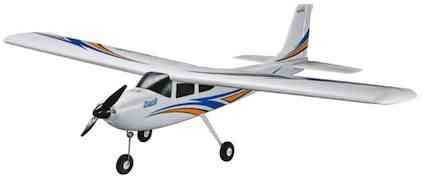
Tower Hobbies' photo of the latest version of the Sensei
Hobbico to Visit Our Area at the Ultimate Soccer Arenas for Two Days in April!
Get a jump on the Toledo Show, which is scheduled for April 10, 11 & 12 this year. Hobbico's first visit is on the evening of Monday, April 6, from 7 p.m. to 9 p.m. at the Ultimate Soccer Arenas in Pontiac, MI. Hobbico will also be represented again on Tuesday, April 7, from 11 a.m. to 1 p.m., the regularly scheduled indoor flying time. The Frank Noll, Futaba Team Manager, is the scheduled representative. There will be a lot of pilots' prizes, so you really don't want to miss this one. The event is sponsored by M.I.A.A. The contact for the event is Joe Hass at 248-321-7934 or joehass@gmail.com. Team USA F3P Pilot Ryan Clark Visits Ultimate Soccer, February 10, 2015
The indoor pilots and aeromodelers from around the Detroit area had a special treat on Tuesday Feb. 10, 2015 at Ultimate Soccer Arenas in Pontiac, MI. Ryan Clark of Canton, MI, a member of the first US team competing in the world F3P (Indoor Pattern) championships, spent the day explaining his magnificent Anubis aircraft and answering questions. The Anubis was designed by fellow team member Devin McGrath. Ryan performed a lunch time demo flight at Ultimate Soccer. The championships will be in Warsaw, Poland in mid March. The program was put together to let area modelers see first hand the amazing technology in the F3P machines and to raise money for the US team. These 42" wonders start with carbon fiber counter rotating props driven by a single brushless motor with no gears. The motor / prop combination sells for $500.00. This engineering feat is matched to a foam framework custom created by Fancy Foam that has been computer cut and milled. Most of the remaining foam is further hand cut away. The structure is then covered in .002 Mylar. Decorative designs are airbrushed on. The entire structure is reinforced with carbon fiber rods. Drag plates are created by suspending the Mylar from some of the carbon fiber structures. The wings are removable for shipping. The DSP33 servos have been gutted by removing the cases and replacing the wiring with motor winding wire. Pushrods have been eliminated at the elevator and rudder by directly connecting the servo output to the control surfaces. All up weight with battery, also modified, is less than 2 ounces. Tables were set up near the entrance to field 3 at Ultimate to display Ryan's aircraft and sell team shirts and raffle tickets. Ryan, fellow Futaba Team member Chris Hass and Chelsea Morneau took care of all who stopped by. Additional tables were set up for the "pizza fundraiser" that was simultaneously used to raise money for the team (make a donation and enjoy some pizza) and to introduce the new restaurant at Ultimate to the pilots and spectators. 29 pizzas were consumed in an hour. Over 150 pilots and spectators participated. An anonymous donor paid for the pizzas so that every dollar collected will go to the team. Indoor Event Director Fred Engelman and his team handled the 50 / 50. Ken Niewoit was the lucky winner of the 50 / 50 and donated some of his prize back to the team. The HVAC system was shut down and the flight lines completely cleared at noon to allow Ryan to fly for the now quiet crowd. With amazing precision and barely moving through the air Ryan performed one of the pattern sequences. The round of applause at the end was thunderous. Fred Engelman and Skymasters President Bob Chadelaine used the gathering to present George Derderian and Tom Korpela of Ultimate a token of appreciation for allowing modelers to use their facility and supporting the "Fly Guys" as the modelers are known to the Ultimate staff. George and Tom donated an extra hour of flying to the pilots in honor of Ryan's accomplishments. Ryan is 22 years old and a senior at Eastern Michigan University studying Aviation Technology. He is an instrument rated private pilot with a high performance endorsement. He is currently working on his commercial rating flying out of Eagle Flight Centre at Willow Run Airport. Ryan has a long history of competitive success in R/C flying in multiple Extreme Flight Championships (XFC), Electric Tournament of Champions (ETOC) and International Miniature Aircraft Club (IMAC) events. Ryan even flies the blimp for the Toledo Walleye Hockey Team events. Besides being an educational and informative event over $1,550.00 was raised toward the $20,000.00 needed to support the US F3P team. For more information on the F3P team, purchase a team shirt or to make a donation visit teamusaf3p.com/. An A123 Distributor Closing
EVDM Corporation, February 20th, 2015 Unfortunately, A123 Systems has elected not to renew the distribution and supply agreement with EVDM Corporation and as a result, we will no longer be able to sell A123 Systems products (cells) after March 15th. We apologize for any inconvenience this may impose upon your business. Please contact at the following person at A123 in regards to your cell needs:
We will continue to sell NEC Energy Solutions battery modules (ALM-12V7, ALM-12V35, etc.) at our new web address: store.buylithiumbatteries.com Regards,
A Take Along Folding Plane
I have been traveling a lot this past 5 months and wanted to keep flying in some of the more mild places I was being sent, many times staying away over the weekend. Anyway, I looked for the toughest, most wind proof, compact, largest flying envelope, easy to fix with tape ultra micro that I had and cut the wings to fold up into a "lunch-box" sized extra carry-on. I have flown the ultra micro Stryker in England, Canada, FL,RI,SC,CA,TX and HI in the last 5 months! I pack the transmitter in my carry-on and the plane in a plastic carrier bag like some folks bring on a sandwich! Home is best, but I have had some great afternoons of flying when it was not possible in Michigan. Cheers!
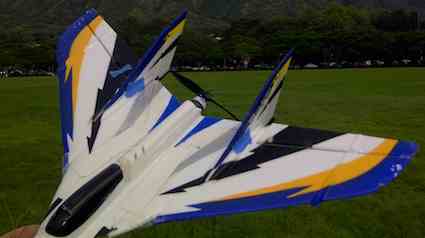 31st Annual Mid-America Electric Flies 2015 Saturday, July 11 & Sunday, July 12
|
To Reach Ken Myers, you can land mail to the address at the top of the page. My E-mail address is: KMyersEFO@theampeer.org
